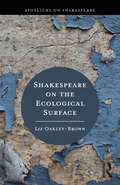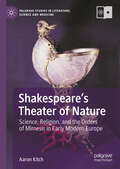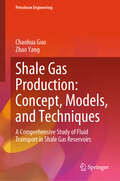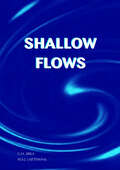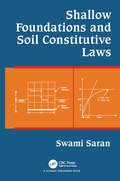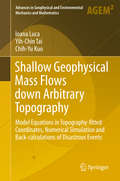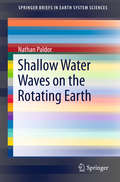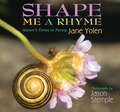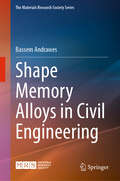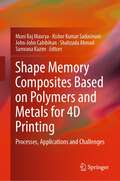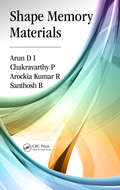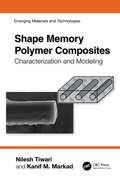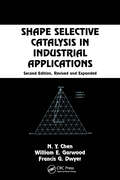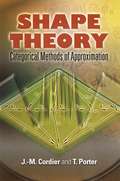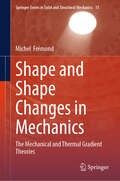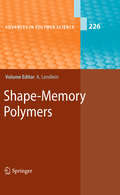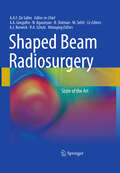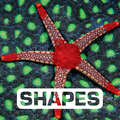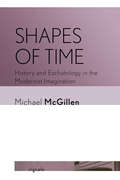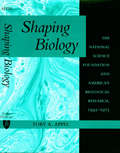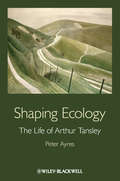- Table View
- List View
Shakespeare on the Ecological Surface (Spotlight on Shakespeare)
by Liz Oakley-BrownShakespeare on the Ecological Surface uses the concept of the ‘surface’ to examine the relationship between contemporary performance and ecocriticism. Each section looks, in turn, at the 'surfaces' of slick, smoke, sky, steam, soil, slime, snail, silk, skin and stage to build connections between ecocriticism, activism, critical theory, Shakespeare and performance. While the word ‘surface’ was never used in Shakespeare’s works, Liz Oakley-Brown shows how thinking about Shakespearean surfaces helps readers explore the politics of Elizabethan and Jacobean culture. She also draws surprising parallels with our current political and ecological concerns. The book explores how Shakespeare uses ecological surfaces to help understand other types of surfaces in his plays and poems: characters’ public-facing selves; contact zones between characters and the natural world; surfaces upon which words are written; and physical surfaces upon which plays are staged. This book will be an illuminating read for anyone studying Shakespeare, early modern culture, ecocriticism, performance and activism.
Shakespearean Sensations
by Katharine A. Craik Tanya PollardThis strong and timely collection provides fresh insights into how Shakespeare's plays and poems were understood to affect bodies, minds and emotions. Contemporary criticism has had surprisingly little to say about the early modern period's investment in imagining literature's impact on feeling. Shakespearean Sensations brings together scholarship from a range of well-known and new voices to address this fundamental gap. The book includes a comprehensive introduction by Katharine A. Craik and Tanya Pollard and comprises three sections focusing on sensations aroused in the plays; sensations evoked in the playhouse; and sensations found in the imaginative space of the poems. With dedicated essays on Hamlet, Macbeth, Othello and Twelfth Night, the collection explores how seriously early modern writers took their relationship with their audiences and reveals new connections between early modern literary texts and the emotional and physiological experiences of theatregoers.
Shakespeare’s Theater of Nature: Science, Religion, and the Orders of Mimesis in Early Modern Europe (Palgrave Studies in Literature, Science and Medicine)
by Aaron KitchShakespeare’s Theater of Nature argues that Shakespeare combined art and nature in new ways while experimenting with relations between words, images, and objects as sources of knowledge and pleasure. Shakespeare’s re-centering of nature as a source of theatrical representation in a range of plays follows debates in natural philosophy and theology about how to understand divinity in and through the order of nature (ordo creationis). Early chapters analyze early modern reframing of nature by printed books of botany, cosmology, and history—as well Tudor interludes that center nature as a subject—while later chapters offer readings of eight plays by Shakespeare that draw on classical, medieval, and early modern debates in natural philosophy and theology to create new modes of dramatic mimesis.
Shale Gas Production: A Comprehensive Study of Fluid Transport in Shale Gas Reservoirs (Petroleum Engineering)
by Zhao Yang Chaohua GuoThis book is a comprehensive overview of shale gas science and engineering, covering key facets such as the geological and geochemical characteristics of shale gas reservoirs, gas transport mechanisms in shale nanopores, mathematical models and case studies for gas production, and enhancing gas recovery methods. The author presents a systematic summarization of gas flow and production in shale gas reservoirs from micropore to macro-reservoir scale. The research methods encompass experiments, well-testing, numerical simulation, and mathematical derivation. Designed primarily as a reference work for petroleum industry practitioners and researchers, this book is equally valuable for new entrants and seasoned professionals. It is also an excellent resource for undergraduate and postgraduate courses and of interest to libraries at universities offering gas, oil, and general energy courses. Whether you're seeking an introduction to the field or a detailed exploration of advanced concepts, this book provides a valuable and complete guide to shale gas science and engineering.
Shallow Flows: Research Presented at the International Symposium on Shallow Flows, Delft, Netherlands, 2003
by Gerhard H. Jirka Wim S.J. UijttewaalThis text presents the key findings of the International Symposium held in Delft in 2003, which explored the process of shallow flows. Shallow flows are found in lowland rivers, lakes, estuaries, bays, coastal areas and in density-stratified atmospheres, and may be observed in puddles, as in oceans. They impact on the life and work of a wide variety of readers, who are here provided with a clear overview of the subject. Shallow flows are intrinsically turbulent. On one hand, there are strongly three-dimensional, small-scale turbulent motions and on the other hand, large-scale quasi-two-dimensional turbulence. This book explains and examines these differences and their effects with sections on transport processes in shallow flows; shallow jets, wakes and mixing layers; stratified and rotating flows in ocean and atmosphere; river and channel flows; and numerical modelling and turbulence closure techniques. The reader is provided with the pick of current studies and a fresh approach to the subject, with expert examination of a fascinating and crucial phenomenon of our world's water systems.
Shallow Foundations and Soil Constitutive Laws
by Swami SaranThe book offers a systematic analysis of footings (i.e. shallow foundations) in a realistic way, using constitutive relationships of the soil. The aim of the book is to deal with the theme holistically, involving the determination of the constitutive law of the soil, and then proportioning the footing occurring in different situations in actual practice. The book has eleven chapters. After giving an introduction and scope of the book in the first chapter, second and third chapters are respectively devoted to constitutive laws of soil and basic stress equations. In the third chapter analysis of strip footings subjected to central vertical load has been dealt. This analysis has been extended for eccentric –inclined load in the fifth chapter. Since problems of shallow foundations resting adjacent to a slope are of prime importance, this aspect has been dealt in sixth chapter. In the seventh chapter, analysis pertaining to square and rectangular footings have been presented. Effect of interference between adjacent footing is covered in chapter eight. Since ring footings are usually provided for tanks, silos, towers etc., ninth chapter is devoted to this. Added attraction of the book is its chapter ten in which footings located in seismic regions have been covered. Effect of embedment below the ground surface on the behavior of footings located both in non-seismic and seismic regions has been dealt in the chapter eleven. The book is intended for senior undergraduate, postgraduate and Ph.D. students of civil engineering, research scholars, practicing engineers, teachers and academicians. The analyses are based on the latest information available. A number of illustrated examples have been included in the text. SI units have been used in the book.
Shallow Geophysical Mass Flows down Arbitrary Topography
by Ioana Luca Yih-Chin Tai Chih-Yu KuoGeophysical mass flows, such as landslides, avalanches or debris flows, are frequent mass movement processes in mountain areas and often cause disastrous damage. This book lays a foundation for formulating the depth-averaged equations describing the shallow geophysical mass flows over non-trivial topography. It consists of the detailed derivation of the model equations. The stimulating numerical examples demonstrate how the proposed models are applied. All this make this book accessible to a wide variety of readers, especially senior undergraduate and graduate students of fluid mechanics, civil engineering, applied mathematics, engineering geology, geophysics or engineers who are responsible for hazard management.
Shallow Water Waves on the Rotating Earth
by Nathan PaldorThis book describes new theoretical advances concerning analytical solutions of the Rotating Shallow Water Equations, which will make it of great interest to graduate students and scientists in the fields of Geophysical Fluid Dynamics, Physical Oceanography, Dynamical Meteorology and Applied Mathematics. The new dispersion relations and meridional amplitude variations of waves derived in this book can be applied to observations in the atmosphere and ocean and also provide alternatives to the Spherical Harmonics basis of global-scale spectral numerical models.
Shanidar, the First Flower People
by Ralph S. SoleckiAn archaeological study conducted from 1951-1960 of the Neanderthal burials found at Shanidar cave in Iraq.
Shape Me a Rhyme: Nature's Forms in Poetry
by Jane YolenIn this unusual collection, poems and photographs focus on shapes in nature. Some shapes are found in familiar places: A circle is the sun and a crescent is the moon. But there are imaginative surprises too: an alligator's tooth is a triangle and a frond's shadow forms a square. Related shape words—round, halo, sphere, etc.—are scattered throughout the spreads. This collaboration captures the beauty of shapes in nature in a playful way.
Shape Memory Alloys in Civil Engineering (The Materials Research Society Series)
by Bassem AndrawesThis book presents a new class of metallic materials, called shape memory alloys (SMAs), as emerging materials for civil engineering applications. These materials have been used for decades in high-end fields like the aerospace and biomedical fields, and possess extraordinary properties that have attracted the attention of civil engineering researchers and practitioners for over 25 years. In this volume, based on 20 years of research findings, the author describes how SMAs started to find their way into practical applications in civil engineering. And that, like any metal, SMAs are produced in any shape, size, or form including wire, bar, and sheet, but unlike other metals, SMAs exhibit a unique ability to recover their original shape/size after being excessively deformed. Given the demand for sustainability and resilience in civil engineering applications, this book is ideal for civil engineering practitioners and materials researchers concerned with building materials and civil infrastructure.
Shape Memory Composites Based on Polymers and Metals for 4D Printing: Processes, Applications and Challenges
by Kishor Kumar Sadasivuni John-John Cabibihan Shahzada Ahmad Samrana Kazim Muni Raj MauryaShape Memory Composites Based on Polymers and Metals for 4D Printing is a thorough discussion of the physics and chemistry behind this developing area of materials science. It provides readers with a clear exposition of shape-memory-composite (SMC) preparation techniques for 3D and 4D printing processes and explains how intelligent manufacturing technology may be applied in fields such as robotics, construction, medical science, and smart sensors. The book covers fundamental background knowledge on the synthesis of shape memory polymers (SMPs) and shape memory alloys (SMAs), and additive manufacturing techniques. Polymers and metals and their roles in 4D printing are dealt with separately, and applications of 4D printing are treated in their own chapter. The different alloy compositions and nanoparticle fillers in polymer composites are examined in detail, along with the key mechanisms involved in their processing. Hybrid nanofillers and synergistic composite mixtures, which are either in extensive current use or have shown promising outcomes in the field of 4D printing, are thoroughly discussed. Differences between these novel SMCs and traditional metal alloys, organic and inorganic composites are presented, and means by which they can improve mechanical properties that are triggered by external sources like magnetic field, temperature, and pH of solvent, are set out. This book provides practitioners, industrial researchers, and scholars with a state-of-the-art overview of SMP/SMA synthesis, additive manufacturing, modification in synthesis of SMCs for 4D printing, and their likely future applications.
Shape Memory Materials
by Chakravarthy P Arockia Kumar R Santhosh B Arun D IThis work addresses the basic principles, synthesis / fabrication and applications of smart materials, specifically shape memory materials <P><P>Based on origin, the mechanisms of transformations vary in different shape memory materials and are discussed in different chapters under titles of shape memory alloys, ceramics, gels and polymers <P><P>Complete coverage of composite formation with polymer matrix and reinforcement filler conductive materials with examples
Shape Memory Polymer Composites: Characterization and Modeling (Emerging Materials and Technologies)
by Nilesh Tiwari Kanif M. MarkadShape Memory Polymer Composites discusses the fabrication of smart polymer composites with their material characterization. It covers shape memory polymer composites with two different types of reinforcement: shape memory polymer nanocomposites and shape memory hybrid composites. Enhancing the mechanical and thermomechanical properties of the shape memory polymers makes them an important class of materials for new age applications ranging from aerospace, biomedical, electronics, to marine engineering. The book discusses how shape memory polymer composites exhibit remarkable mechanical properties, as compared to its corresponding shape memory polymers, without compromising the shape memory behavior. It presents experimental case studies of polymers, polymer composites, and multiphase composites, explaining the effects of each reinforcement on the material properties with corresponding simulation. The book will be a useful reference for industry professionals and researchers involved with the mechanics of shape memory materials.
Shape Selective Catalysis in Industrial Applications, Second Edition, (Chemical Industries Ser. #65)
by N.Y. Chen"Examines all known industrial processes using shape selective zeolites. Second Edition contains new, up-to-date information on the specific features that make zeolites shape selective, the role shape selective catalysis can play providing environmentally clean fuels, 12-membered oxygen ring systems, mesopore systems, and more."
Shape Theory: Categorical Methods of Approximation (Dover Books on Mathematics)
by T. Porter J. M. CordierThis in-depth treatment uses shape theory as a "case study" to illustrate situations common to many areas of mathematics, including the use of archetypal models as a basis for systems of approximations. It offers students a unified and consolidated presentation of extensive research from category theory, shape theory, and the study of topological algebras.A short introduction to geometric shape explains specifics of the construction of the shape category and relates it to an abstract definition of shape theory. Upon returning to the geometric base, the text considers simplical complexes and numerable covers, in addition to Morita's form of shape theory. Subsequent chapters explore Bénabou's theory of distributors, the theory of exact squares, Kan extensions, the notion of a stable object, and stability in an Abelian context. The text concludes with a brief description of derived functors of the limit functor theory--the concept that leads to movability and strong movability of systems--and illustrations of the equivalence of strong movability and stability in many contexts.
Shape and Shape Changes in Mechanics: The Mechanical and Thermal Gradient Theories (Springer Series in Solid and Structural Mechanics #15)
by Michel FrémondThis book provides an innovative description of motion with large deformations and the possibility of defects and dislocations. The theory is based on the stretch and angular matrices of the polar decomposition allowing convex potentials. Third-order gradient theories are required to account for mechanical everyday experiments, for instance assemblies of solid structures with different spatial dimensions. Second-order gradient theories are required for thermal experiments. Using the principle of virtual power and new convex potentials, the position of either solid or fluid structures together with the matrix accounting for the defects and dislocations is computed. Defects and dislocations are present in case an internal stress is large enough. Engineers and scientists active in solid and fluid engineering, mathematics, and numerics should be aware of this predictive theory. Damage, shape memory alloys, Cosserat materials, and surface tension are investigated in this framework.
Shape-Memory Polymers
by Andreas LendleinTable of Contents -Shape-Memory Polymers and Shape-Changing Polymers By M. Behl, J. Zotzmann, and A. Lendlein -Shape-Memory Polymer Composites By Samy A. Madbouly and Andreas Lendlein -Characterization Methods for Shape-Memory Polymers By W. Wagermaier, K. Kratz, M. Heuchel, and A. Lendlein -Shape-Memory Polymers for Biomedical Applications By Christopher M. Yakacki and Ken Gall -Controlled Drug Release from Biodegradable Shape-Memory Polymers By ChristianWischke, Axel T. Neffe, and Andreas Lendlein
Shaped Beam Radiosurgery
by Antonio A. De Salles Alessandra Gorgulho Michael Selch Raymond Schulz Aaron J. Burwick Nzhde Agazaryan Ben SlotmanNovalis® Shaped Beam Radiosurgery has set new standards by delivering highly precise radiation treatments to tumors anywhere in the body through the use of a proprietary multileaf collimator. By shaping the radiation beam to the exact contours of the tumor or lesion, Novalis permits maximum dose delivery to the entire tumor while protecting healthy tissue; this makes it eminently suitable for the treatment of irregularly shaped tumors. This book provides a complete guide to radiosurgery treatments with Novalis. After a thorough discussion of the clinical and technical basis for Shaped Beam Radiosurgery, current clinical applications are considered in detail, including brain, body, skull base, and spinal tumors as well as arteriovenous malformations. Careful consideration is also given to future developments and applications, including new technologies that promise to offer even more accurate treatments. This state-of-the-art book will appeal to a wide audience of physicians and their multidisciplinary clinical and technical collaborators.
Shapes (Picture This)
by Judith NouvionShapes are everywhere in nature. Discover many different kinds in these eye-catching photographs of animals in our natural world. From the line that pigeons form on a telephone wire to the square body of a ghost crab, children will find the many shapes that exist in our natural world in vibrant color photography. Perfect for very new and curious learners!
Shapes of Time: History and Eschatology in the Modernist Imagination (Signale: Modern German Letters, Cultures, and Thought)
by Michael McGillenShapes of Time explores how concepts of time and history were spatialized in early twentieth-century German thought. Michael McGillen locates efforts in German modernism to conceive of alternative shapes of time—beyond those of historicism and nineteenth-century philosophies of history—at the boundary between secular and theological discourses. By analyzing canonical works of German modernism—those of Karl Barth, Franz Rosenzweig, Siegfried Kracauer, and Robert Musil—he identifies the ways in which spatial imagery and metaphors were employed to both separate the end of history from a narrative framework and to map the liminal relation between history and eschatology.Drawing on theories and practices as disparate as constructivism, non-Euclidean geometry, photography, and urban architecture, Shapes of Time presents original connections between modernism, theology, and mathematics as played out within the canon of twentieth-century German letters. Concepts of temporal and spatial form, McGillen contends, contribute to the understanding not only of modernist literature but also of larger theoretical concerns within modern cultural and intellectual history.
Shaping Biology: The National Science Foundation and American Biological Research, 1945-1975
by Toby A. AppelHistorians of the postwar transformation of science have focused largely on the physical sciences, especially the relation of science to the military funding agencies. In Shaping Biology, Toby A. Appel brings attention to the National Science Foundation and federal patronage of the biological sciences. Scientists by training, NSF biologists hoped in the 1950s that the new agency would become the federal government's chief patron for basic research in biology, the only agency to fund the entire range of biology—from molecules to natural history museums—for its own sake. Appel traces how this vision emerged and developed over the next two and a half decades, from the activities of NSF's Division of Biological and Medical Sciences, founded in 1952, through the cold war expansion of the 1950s and 1960s and the constraints of the Vietnam War era, to its reorganization out of existence in 1975. This history of NSF highlights fundamental tensions in science policy that remain relevant today: the pull between basic and applied science; funding individuals versus funding departments or institutions; elitism versus distributive policies of funding; issues of red tape and accountability.In this NSF-funded study, Appel explores how the agency developed, how it worked, and what difference it made in shaping modern biology in the United States. Based on formerly untapped archival sources as well as on interviews of participants, and building upon prior historical literature, Shaping Biology covers new ground and raises significant issues for further research on postwar biology and on federal funding of science in general.
Shaping Children: Ethical and Social Questions that Arise when Enhancing the Young (Advances in Neuroethics)
by Saskia K. NagelThe volume offers a unique collection of articles on pediatric neuroenhancement from an international and multidisciplinary perspective. In recent years, the topic of “neuroenhancement” has become increasingly relevant in academia and practice, as well as among the public. While autonomous adults are free to choose neuroenhancement, in children it presents its own ethical, social, legal, and developmental issues. A plethora of potential (neurotechnological) enhancement agents are on the market. While the manifold issues surrounding the topic have been extensively discussed, there is little work on the specific questions that arise in children and adolescents. This book addresses this gap in the literature: Next to conceptual and normative work on autonomy and self-control, the collection explores the implications for parenting and schooling, and provides input for a discussion of public attitudes. It is a valuable resource for the different academic communities confronted with questions of how to evaluate and approach enhancement in children and is of interest to neuroethicists, scholars in applied ethics and neurology, psychiatrists and psychologists as well as scientists developing enhancement interventions for children.
Shaping Earth's Surface: Ice
by Nash KramerIn this book you will learn how ice shapes Earth's surface.
Shaping Ecology: The Life of Arthur Tansley
by Peter G. AyresSir Arthur Tansley was the leading figure in ecology for the first half of the 20th century, founding the field, and forming its first professional societies. He was the first President of the British Ecological Society and the first chair of the Field Studies Council. His work as a botanist is considered seminal and he is recognized as one of the giants of ecology throughout the world. Ecology underpins the principles and practices of modern conservation and the maintenance of biodiversity. It explains the causes of, and offers solutions to, problems of climate change. Yet ecology is a young science, barely 100 years old. Its origins lie in phytogeography, the naming and mapping of plants. Shaping Ecology is a book about a multi-faceted man whose friends included Bertrand Russell, Marie Stopes, Julian Huxley, GM Trevelyan, and Solly Zuckerman. Historical context is provided by Tansley's family for his parents moved in the Fabian-socialist world of John Ruskin and Octavia Hill, both instrumental in the foundation of the National Trust. While Britain was relatively slow to protect its green spaces and wildlife, it did establish in 1913 the first professional Ecological Society in the world. Tansley was its President. Organising the British Vegetation Committee and initiating a series of International Phytogeographic Excursions, he changed phytogeography into ecology.
